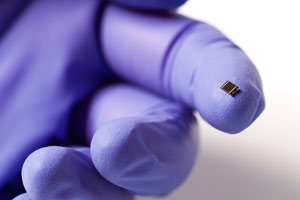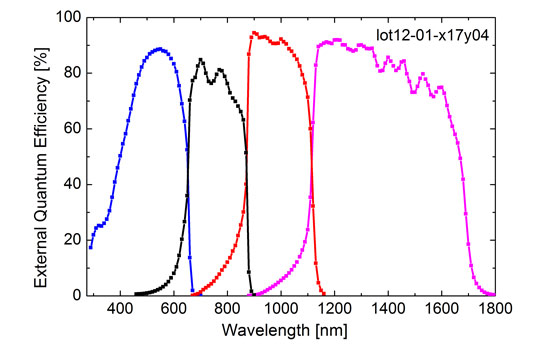- News
24 September 2013
Fraunhofer ISE, Soitec, Leti and Helmholtz Center achieve record 44.7% solar cell efficiency
The Fraunhofer Institute for Solar Energy Systems ISE in Freiburg, Germany, concentrated photovoltaic (CPV) system maker Soitec of Bernin, France, micro/nanotechnology R&D center CEA-Leti in Grenoble, France and the Helmholtz Zentrum Berlin have jointly achieved a new record for solar energy conversion efficiency by using a new cell structure with four subcells.
 Picture:
Record 44.7%-efficient solar cell, for use in CPV.
Picture:
Record 44.7%-efficient solar cell, for use in CPV.
Previously, in May, the German-French team reported a four-junction solar cell with 43.6% efficiency, while Solar Junction Corp of San Jose, CA, USA reported a 44.1%-efficient production-ready cell in August following Sharp in June reporting a 44.4%-efficient triple-junction cell in research. After just over three years of research on the four-junction solar cell, the the German-French team’s new record of 44.7% was measured at a concentration of 297 suns. The latest figure is cited as a major step on the roadmap towards 50% efficiency.
The solar cells are for use in CPV, which can achieve more than twice the efficiency of conventional PV power plants in sun-rich locations. Originating from space technology, the terrestrial use of III-V multi-junction solar cells has prevailed to realize the highest solar energy conversion efficiencies. In the latest multi-junction solar cell, several cells made out of different III-V semiconductor materials are stacked on top of each other, with each single subcell absorbing different wavelength ranges of the solar spectrum.

Picture: I-V characteristic for record four-junction solar cell under AM1.5d ASTM G173-03 spectrum at a concentration of 297 suns. Measurements were carried out at the Fraunhofer ISE CalLab. ©Fraunhofer ISE
“Besides improved materials and optimization of the structure, a new procedure called wafer bonding plays a central role,“ says Frank Dimroth, department head & project leader in charge of the development work at Fraunhofer ISE. “With this technology, we are able to connect two semiconductor crystals, which otherwise cannot be grown on top of each other with high crystal quality. In this way we can produce the optimal semiconductor combination to create the highest efficiency solar cells,” he adds.

Picture: External quantum efficiency of four-junction solar cell. Measurement was performed at the Fraunhofer ISE CalLab. ©Fraunhofer ISE
“This world record, increasing our efficiency level by more than 1 point in less than 4 months, demonstrates the extreme potential of our four-junction solar cell design, which relies on Soitec bonding techniques and expertise,” notes Soitec’s chairman & CEO André-Jacques Auberton-Hervé. “It confirms the acceleration of the roadmap towards higher efficiencies, which represents a key contributor to competitiveness of our own CPV systems,” he adds.
“This new record value reinforces the credibility of the direct semiconductor bonding approaches that is developed in the frame of our collaboration with Soitec and Fraunhofer ISE,“ believes Leti CEO Laurent Malier.
Concentrator modules are produced by Soitec (beginning in 2005 under the name Concentrix Solar, a spin-off of Fraunhofer ISE). The technology is employed in solar power plants located in sun-rich regions with a high percentage of direct radiation. Currently Soitec has CPV installations in 18 different countries, including Italy, France, South Africa and the USA (California).
Fraunhofer ISE and Soitec achieve 43.6% efficiency with four-junction CPV cell
Fraunhofer ISE raises multi-junction solar cell efficiency record to 41.1%
Fraunhofer ISE Leti Soitec CPV Helmholtz





